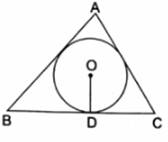In the given figure, a triangle ABC is drawn to circumscribe a circle of radius 2 cm such that the segments BD and DC into which BC is divided by the point of contact D, are of lengths 4 cm and 3 cm respectively. If the area of ΔABC = 21 cm2 then find the lengths of sides AB and AC.

Given: △ABC that is drawn to circumscribe a circle with radius r = 2 cm and BD = 4 cm DC = 3cm
Also, area(△ABC) = 21 cm2
To Find: AB and AC
Now,
As we know tangents drawn from an external point to a circle are equal.
Then,
FB = BD = 4 cm [Tangents from same external point B]
DC = EC = 3 cm [Tangents from same external point C]
AF = EA = x (let) [Tangents from same external point A]
Using the above data, we get
AB = AF + FB = x + 4 cm
AC = AE + EC = x + 3 cm
BC = BD + DC = 4 + 3 = 7 cm
Now we have heron's formula for area of triangles if its three sides a, b and c are given
![]()
Where, ![]()
So, for △ABC
a = AB = x + 4
b = AC = x + 3
c = BC = 7 cm
⇒ ![]()
And
![]()
![]()
Squaring both sides,
21(21) = 12x(x + 7)
12x2 + 84x - 441 = 0
4x2 + 28x - 147 = 0
As we know roots of a quadratic equation in the form ax2 + bx + c = 0 are,
![]()
So roots of this equation are,
![]()
![]()
![]()
but x = - 10.5 is not possible as length can't be negative.
So
AB = x + 4 = 3.5 + 4 = 7.5 cm
AC = x + 3 = 3.5 + 3 = 6.5 cm